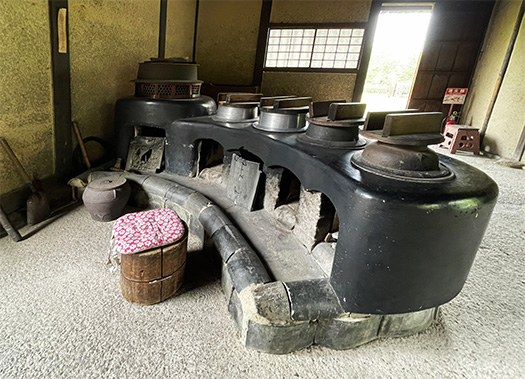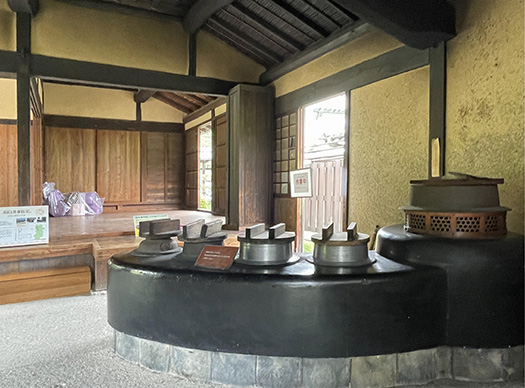

さて本日から通常の住宅探訪シリーズに復帰いたします。
奈良県での飛鳥、纏向の探訪シリーズの延長で大和郡山の奈良県立民俗博物館
野外展示の古民家群からであります。
写真の住宅は旧・臼井家住宅。建築推定年代は1700年代初期。
いまから300年前の住宅ということになります。
移築復元前は高市郡高取町上土佐にあった町家建築。
このあたりの建築の素性その他については明日以降紹介します。
とにかく目を驚かされるのがこの調理火力「おくどさん」であります。
カマドは日本人のいのちを支え続けた基本火力。
薪などのバイオマス熱源をエネルギー源にして
日本人の基本食であるコメの調理に最適化された装置。
始めちょろちょろ、なかパッパ、赤子泣いても・・・、
という日本食の基本中の基本ですが、
土間のなかでドーンと構えていて迫力がある。
こちらの家では5つの火力プレートが装置されている。
大家族のため、というよりももっと多くの人間の用に供されたか。
上の写真ではそれぞれのプレートに対して火力調節口が見えている。
適時薪をくべながらあれこれの料理を作っていったのでしょう。
その火加減を管理するための腰掛け椅子も置かれて
いかにも日本のおかあさん、母性が食を支えている様子が伝わってくる。
これだけの集中火力なので熱効率はかなり高かったことでしょう。
手前側も含めて3方向に開口部が開いていて
通風換気によって燃焼効率を確保している。
おくどさんの外装仕上げとして黒く塗装されていて、
現代のシステムキッチンよりもはるかに美観的訴求力。
火力管理する側に対して微妙に円形配置されていることで
機能性デザイン性双方で強いインパクト。
石の土台が敷かれその上に乗っかっているが、
手前側調理管理者側にはもう1段の石積みが施されている。
用済みになった灰などを手前側に掻きだし、処分する用途がわかる。
見ているとつい扱ってみたくなる(笑)。
これだけの強力火力装置であれば、火を通しにくい手強い根菜類も
じっくり手懐けることがカンタンにできそうに思われる。
そしてボリューム感、楕円形状の機能性とも
現代のキッチンに対して取り入れていくことが可能なのではないか。
なにより個性的で親しみやすいその姿は、
いかにも「毎日の食生活を楽しくします」みたいなメッセージ力がある。
こちらの野外展示古民家群では、このタイプの「おくどさん」が多数派。
全国の古民家を見ているけれど、奈良には共通性があるのか。
そうであれば、独特の作り手、その文化が存在するように思われた次第。
English version⬇
Cooking fire power “Okudosan” in an old minka (traditional Japanese house) in Nara, Yamato Historical Testimony-17
The fire power that sustains life. The performance and design grab your attention. The oval flat surface and black shiny rounded exterior appeal to mother nature. ・・・・・.
Today we will return to our regular series of house visits.
As an extension of the Asuka and Mukai series in Nara Prefecture, we will be returning to the Nara Prefectural Museum of Folklore in Yamatokoriyama.
This is from a group of old houses in the open-air exhibition at Nara Prefectural Museum of Folklore in Yamatokoriyama, Nara Prefecture.
The house in the photo is the former Usui Family Residence. The estimated date of construction is early 1700s.
It was built 300 years ago.
Before the reconstruction, the house was located in Kamitosa, Takatori Town, Takaichi County.
I will introduce the architectural background of the house and other details tomorrow.
The most striking feature of the house is the cooking fireplace “okudo-san”.
Kamado is the basic heat source that has sustained the life of the Japanese people.
It uses biomass heat sources such as firewood as its energy source.
This device is optimized for cooking rice, the basic food of the Japanese people.
The basic Japanese food, “Start a little bit, then a little bit, then a little bit, then a little bit, then a little bit, then a little bit….
The basic of Japanese food.
The kitchen is a powerful one, standing in the earthen floor.
In this house, there are five heat plates.
They are used not only for a large family, but also for many other people.
In the photo above, you can see the heat control ports for each plate.
It is likely that the cooks cooked various dishes while lighting the firewood at the right time.
A chair was also placed to control the heat level.
This is a scene that shows how Japanese mothers and motherhood support food preparation.
The heat efficiency must have been quite high because of the concentrated heat.
There are openings in three directions, including the front side.
Combustion efficiency is ensured by ventilation.
It was painted black as an exterior finish for the okudo.
aesthetic appeal much more than modern system kitchens.
The subtle circular arrangement against the fire control side has a strong impact on both functionality and design.
The circular arrangement of the fire control side has a strong impact in terms of both functionality and design.
The stone base is laid on top of the stone base.
The cooking manager’s side in the foreground has another layer of stone piles.
It is clear that this is used to scrape out and dispose of used ashes and other materials on the front side.
Looking at it makes me want to handle it (laughs).
With such a powerful fireplace, even tough root vegetables that are difficult to heat through can be slowly tamed.
It seems that with such a powerful device, it would be easy to tame even the toughest root vegetables that are difficult to heat through.
The volume and the functionality of the elliptical shape are both
The volume and functionality of the oval shape could be incorporated into the modern kitchen.
Above all, the unique and friendly appearance of the kitchenware is surely “enjoyable for everyday dining.
The unique and friendly appearance of the kitchen is a message of “making your daily eating life more enjoyable.
This type of “okudo-san” is the majority in this group of old houses on display in the open-air exhibition.
I have been looking at old private houses all over Japan, but is there a commonality in Nara?
If so, it seems that there is a unique culture and creator of these old houses in Nara.
Posted on 7月 13th, 2022 by 三木 奎吾
Filed under: 住宅取材&ウラ話, 日本社会・文化研究







コメントを投稿
「※誹謗中傷や、悪意のある書き込み、営利目的などのコメントを防ぐために、投稿された全てのコメントは一時的に保留されますのでご了承ください。」
You must be logged in to post a comment.